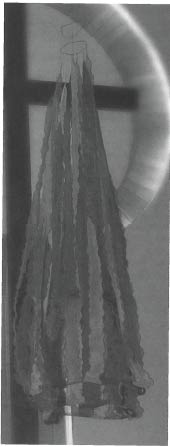Updated May, 2025
Our liturgical arts committee aims to include color, music, motion, and symbolism in worship. For Pentecost, we wanted to symbolize how the Holy Spirit came upon the disciples with wind and flame.
There are many ways to depict a flame, but depicting wind is more difficult. To capture the motion of both and remind us of the motion of the Holy Spirit, we used wind to blow the flames of an 8-foot-tall fabric fire.
We decided to hang the flame at the front of the sanctuary where worship is focused (though not directly over the pastor’s head). The flame could also be hung above the congregation to reflect how the Holy Spirit is moving among them, or at the sanctuary exit to symbolize how the Holy Spirit goes forth with God’s people.

Materials and Construction
Flames
Organza, 2.5 yards (2 m) of each of the following colors: red, orange, gold (not metallic), yellow
Contrasting colored thread
Serger sewing machine
- Cut fabric on the bias (diagonal to the weave) into strips 4 inches (10 cm) wide. The strips (flames) should vary in length from 3-6 feet (1-2 m).
- Finish each strip off with a rolled hem on a serger in a contrasting color. Stretch the fabric while you sew to create a wave along the edges (a little like lasagna noodles). Finish one end of each flame to a point, leaving a string of serged threads 3-4 inches (8-10 cm) on the tip. Fold the other end of each flame over about 1" (2.5 cm) and sew it into a sleeve.
Support Structure
Copper and bronze wire
Fishing line (6-lb and 20-lb)
Needle for fishing line
Hot glue gun
Fan
Metal ring (made of twisted brass wire, or use a sturdy key ring)
- There are three nested tiers of flames. Each tier starts with copper wire; we used electrical wire bendable by hand but stiff enough not to bend under its own weight. For the largest tier, cut a 5-foot (2.5 m) length of wire, and thread approximately 22 flames of varying length and color on through their sleeves. Twist the ends of the wire to form a hoop 28" (70 cm) in diameter. Adjust the flames to cover where the wire is joined.
- Twist a finer piece of copper or bronze wire (we used jewelry wire) into a circle 8" (20 cm) in diameter. (Depending on the gauge of the wire you may want to twist additional wire around the circle for strength.) Suspend the large hoop from the small hoop at four points using fishing line. It doesn’t matter if it hangs a little crooked. Use a dab of hot glue to keep the tied ends of the fishing line in place on the top hoop. The distance between the hoops should be approximately an inch (2.5 cm) longer than the longest flame.
- Use a needle and thread to secure fishing line to the pointed tip of each flame. These lines are also tied to the upper hoop (and dabbed with hot glue)—leave a little slack so each flame has a slight sag to it.
- Suspend the upper hoop 4" (10 cm) from a metal ring using fishing wire.
- Construct two other tiers using the same technique, one with a lower hoop diameter of 20" (50 cm) and sixteen flames and a maximum height of 5' 10" (1.8 m) and the other with a hoop diameter of 16" (40 cm) and thirteen flames with a maximum height of 4' 7" (1.4 m). The tiers are then nested (with the largest hoop on the outside) and tied to the top ring.

Installation
Suspend the finished flame from the ceiling so the bottom hoop is approximately 8' (2.5 m) above the floor. Our sanctuary ceiling is too high so we suspended it from four points high on the walls, two on the front wall and two on the side walls about 8' back from the front wall. Four points allows a significant degree of adjustment in location. Although the flame is not heavy, this kind of suspension puts significant tension on the lines. We used double stranded 20 lb. fishing line.
Lay a fan on the floor so that it will blow directly up under the flame (if necessary, set it on bricks or blocks so it can draw air from underneath). The wind from the fan will cause the flames to flutter.
Approximate cost:
$83 US ($100 CDN) for fabric and thread
$25 US ($30.00 CDN) for wire and fishing line
Estimated time:
4 hours to cut fabric
10 hours to sew and assemble
(Estimated time is for one person: more help is needed to install the finished flame in the sanctuary.
